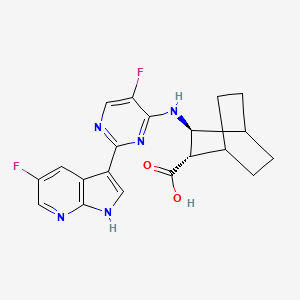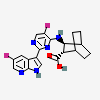Pimodivir
- Pimodivir
- 1629869-44-8
- VX-787
- Pimodivir [USAN]
- JNJ872
- Create:2012-11-30
- Modify:2025-01-18

- (2S,3S)-3-((5-Fluoro-2-(5-fluoro-1H-pyrrolo(2,3-b)pyridin-3-yl)-4-pyrimidinyl)amino)bicyclo(2.2.2)octane-2-carboxylic acid
- Bicyclo(2.2.2)octane-2-carboxylic acid, 3-((5-fluoro-2-(5-fluoro-1H-pyrrolo(2,3-b)pyridin-3-yl)-4-pyrimidinyl)amino)-, (2S,3S)-
- JNJ-63623872
- pimodivir
- VX-787
- Pimodivir
- 1629869-44-8
- VX-787
- Pimodivir [USAN]
- JNJ872
- JNJ-63623872
- Vx-787 anhydrous base
- JNJ-63623872-ZCD
- JNJ63623872
- DFC121MXC3
- CHEMBL3318007
- JNJ-872
- (2S,3S)-3-((5-fluoro-2-(5-fluoro-1H-pyrrolo[2,3-b]pyridin-3-yl)pyrimidin-4-yl)amino)bicyclo[2.2.2]octane-2-carboxylic acid
- (2s,3s)-3-[[5-Fluoranyl-2-(5-Fluoranyl-1h-Pyrrolo[2,3-B]pyridin-3-Yl)pyrimidin-4-Yl]amino]bicyclo[2.2.2]octane-2-Carboxylic Acid
- (2S,3S)-3-[[5-fluoro-2-(5-fluoro-1H-pyrrolo[2,3-b]pyridin-3-yl)pyrimidin-4-yl]amino]bicyclo[2.2.2]octane-2-carboxylic acid
- Bicyclo(2.2.2)octane-2-carboxylic acid, 3-((5-fluoro-2-(5-fluoro-1H-pyrrolo(2,3-b)pyridin-3-yl)-4-pyrimidinyl)amino)-, (2S,3S)-
- (2S,3S)-3-[(5-FLUORO-2-{5-FLUORO-1H-PYRROLO[2,3-B]PYRIDIN-3-YL}PYRIMIDIN-4-YL)AMINO]BICYCLO[2.2.2]OCTANE-2-CARBOXYLIC ACID
- 21G
- Pimodivir(VX-787
- 4p1u
- Pimodivir(VX-787?
- PIMODIVIR [INN]
- Pimodivir (USAN/INN)
- Pimodivir (VX-787)
- UNII-DFC121MXC3
- PIMODIVIR [WHO-DD]
- SCHEMBL2128140
- SCHEMBL16728380
- SCHEMBL20150447
- DTXSID801028095
- EX-A1387
- BDBM50050712
- HY-12353A
- AKOS040758584
- AT13207
- CS-6423
- DB14974
- VX -787
- NCGC00510523-01
- AC-30922
- DA-66724
- MS-26767
- JNJ - 63623872 - ZCD
- D11287
- EN300-365064
- Q27276370
- (1R,2S,3S,4R)-3-{[5-fluoro-2-(5-fluoro-1H-pyrrolo[2,3-b]pyridin-3-yl)pyrimidin-4-yl]amino}bicyclo[2.2.2]octane-2-carboxylic acid
- (2S,3S)-3-((5-FLUORO-2-(5-FLUORO-1H-PYRROLO(2,3-B)PYRIDIN- 3-YL)PYRIMIDIN-4-YL)AMINO)BICYCLO(2.2.2)OCTANE-2-CARBOXYLIC ACID
- (2S,3S)-3-(5-FLUORO-2-(5-FLUORO-1H-PYRROLO(2,3-B)PYRIDIN-3-YL)PYRIMIDIN-4-YLAMINO)BICYCLO(2.2.2)OCTANE-2-CARBOXYLIC ACID
- 1259366-34-1
- rel-(2S,3S)-3-((5-Fluoro-2-(5-fluoro-1h-pyrrolo[2,3-b]pyridin-3-yl)pyrimidin-4-yl)amino)bicyclo[2.2.2]octane-2-carboxylic acid

H317 (100%): May cause an allergic skin reaction [Warning Sensitization, Skin]
H362 (100%): May cause harm to breast-fed children [Reproductive toxicity, effects on or via lactation]
P203, P260, P261, P263, P264, P270, P272, P280, P302+P352, P318, P321, P333+P317, P362+P364, and P501
(The corresponding statement to each P-code can be found at the GHS Classification page.)
Skin Sens. 1B (100%)
Lact. (100%)
Patents are available for this chemical structure:
https://patentscope.wipo.int/search/en/result.jsf?inchikey=JGPXDNKSIXAZEQ-SBBZOCNPSA-N
- ChEMBLLICENSEAccess to the web interface of ChEMBL is made under the EBI's Terms of Use (http://www.ebi.ac.uk/Information/termsofuse.html). The ChEMBL data is made available on a Creative Commons Attribution-Share Alike 3.0 Unported License (http://creativecommons.org/licenses/by-sa/3.0/).http://www.ebi.ac.uk/Information/termsofuse.htmlChEMBL Protein Target Treehttps://www.ebi.ac.uk/chembl/g/#browse/targets
- Therapeutic Target Database (TTD)
- ChemIDplusChemIDplus Chemical Information Classificationhttps://pubchem.ncbi.nlm.nih.gov/source/ChemIDplus
- DrugBankLICENSECreative Common's Attribution-NonCommercial 4.0 International License (http://creativecommons.org/licenses/by-nc/4.0/legalcode)https://www.drugbank.ca/legal/terms_of_use
- EPA DSSToxCompTox Chemicals Dashboard Chemical Listshttps://comptox.epa.gov/dashboard/chemical-lists/
- FDA Global Substance Registration System (GSRS)LICENSEUnless otherwise noted, the contents of the FDA website (www.fda.gov), both text and graphics, are not copyrighted. They are in the public domain and may be republished, reprinted and otherwise used freely by anyone without the need to obtain permission from FDA. Credit to the U.S. Food and Drug Administration as the source is appreciated but not required.https://www.fda.gov/about-fda/about-website/website-policies#linking
- ClinicalTrials.govLICENSEThe ClinicalTrials.gov data carry an international copyright outside the United States and its Territories or Possessions. Some ClinicalTrials.gov data may be subject to the copyright of third parties; you should consult these entities for any additional terms of use.https://clinicaltrials.gov/ct2/about-site/terms-conditions#Use
- NCI Thesaurus (NCIt)LICENSEUnless otherwise indicated, all text within NCI products is free of copyright and may be reused without our permission. Credit the National Cancer Institute as the source.https://www.cancer.gov/policies/copyright-reuseNCI Thesaurushttps://ncit.nci.nih.gov
- Open TargetsLICENSEDatasets generated by the Open Targets Platform are freely available for download.https://platform-docs.opentargets.org/licence
- EU Clinical Trials Register
- European Chemicals Agency (ECHA)LICENSEUse of the information, documents and data from the ECHA website is subject to the terms and conditions of this Legal Notice, and subject to other binding limitations provided for under applicable law, the information, documents and data made available on the ECHA website may be reproduced, distributed and/or used, totally or in part, for non-commercial purposes provided that ECHA is acknowledged as the source: "Source: European Chemicals Agency, http://echa.europa.eu/". Such acknowledgement must be included in each copy of the material. ECHA permits and encourages organisations and individuals to create links to the ECHA website under the following cumulative conditions: Links can only be made to webpages that provide a link to the Legal Notice page.https://echa.europa.eu/web/guest/legal-notice(2S,3S)-3-{[5-FLUORO-2-(5-FLUORO-1H-PYRROLO[2,3-B]PYRIDIN-3-YL)PYRIMIDIN-4-YL]AMINO}BICYCLO[2.2.2]OCTANE-2-CARBOXYLIC ACID (EC: 944-438-9)https://echa.europa.eu/information-on-chemicals/cl-inventory-database/-/discli/details/253928(2S,3S)-3-{[5-FLUORO-2-(5-FLUORO-1H-PYRROLO[2,3-B]PYRIDIN-3-YL)PYRIMIDIN-4-YL]AMINO}BICYCLO[2.2.2]OCTANE-2-CARBOXYLIC ACIDhttps://echa.europa.eu/substance-information/-/substanceinfo/100.245.692
- European Medicines Agency (EMA)LICENSEInformation on the European Medicines Agency's (EMA) website is subject to a disclaimer and copyright and limited reproduction notices.https://www.ema.europa.eu/en/about-us/legal-notice
- KEGGLICENSEAcademic users may freely use the KEGG website. Non-academic use of KEGG generally requires a commercial licensehttps://www.kegg.jp/kegg/legal.htmlAntiinfectiveshttp://www.genome.jp/kegg-bin/get_htext?br08307.keg
- Metabolomics Workbench
- Protein Data Bank in Europe (PDBe)
- Springer Nature
- Thieme ChemistryLICENSEThe Thieme Chemistry contribution within PubChem is provided under a CC-BY-NC-ND 4.0 license, unless otherwise stated.https://creativecommons.org/licenses/by-nc-nd/4.0/
- Wikidata
- Wikipedia24S-Hydroxycholesterolhttps://en.wikipedia.org/wiki/24S-Hydroxycholesterol
- PubChemPFAS and Fluorinated Compounds in PubChemhttps://gitlab.com/uniluxembourg/lcsb/eci/pubchem-docs/-/raw/main/pfas-tree/PFAS_Tree.pdf?inline=false
- Medical Subject Headings (MeSH)LICENSEWorks produced by the U.S. government are not subject to copyright protection in the United States. Any such works found on National Library of Medicine (NLM) Web sites may be freely used or reproduced without permission in the U.S.https://www.nlm.nih.gov/copyright.html
- MolGenieMolGenie Organic Chemistry Ontologyhttps://github.com/MolGenie/ontology/
- PATENTSCOPE (WIPO)SID 393074681https://pubchem.ncbi.nlm.nih.gov/substance/393074681

